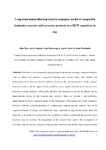Mostrar o rexistro simple do ítem
Long-term non-isothermal reactive transport model of compacted bentonite, concrete and corrosion products in a HLW repository in clay
| dc.contributor.author | Mon, Alba | |
| dc.contributor.author | Samper, Javier | |
| dc.contributor.author | Montenegro, Luis | |
| dc.contributor.author | Naves, Acacia | |
| dc.contributor.author | Fernández Ruiz, Jesús | |
| dc.date.accessioned | 2024-02-05T20:18:59Z | |
| dc.date.available | 2024-02-05T20:18:59Z | |
| dc.date.issued | 2017 | |
| dc.identifier.citation | MON, A., SAMPER, J., MONTENEGRO, L., NAVES, A., FERNÁNDEZ, J. (2017). Long-term non-isothermal reactive transport model of compacted bentonite, concrete and corrosion products in a HLW repository in clay. Journal of Contaminant Hydrology 197 (2017) 1–16. https://doi.org/10.1016/j.jconhyd.2016.12.006 | es_ES |
| dc.identifier.uri | http://hdl.handle.net/2183/35424 | |
| dc.description | Versión aceptada de https://doi.org/10.1016/j.jconhyd.2016.12.006 | es_ES |
| dc.description.abstract | [Abstract:] Radioactive waste disposal in deep geological repositories envisages engineered barriers such as carbon-steel canisters, compacted bentonite and concrete liners. The stability and performance of the bentonite barrier could be affected by the corrosion products at the canister-bentonite interface and the hyper-alkaline conditions caused by the degradation of concrete at the bentonite-concrete interface. Additionally, the host clay formation could also be affected by the hyper-alkaline plume at the concrete-clay interface. Here we present a non-isothermal multicomponent reactive transport model of the long-term (1 Ma) interactions of the compacted bentonite with the corrosion products of a carbon-steel canister and the concrete liner of the engineered barrier of a high-level radioactive waste repository in clay. Model results show that magnetite is the main corrosion product. Its precipitation reduces significantly the porosity of the bentonite near the canister. The degradation of the concrete liner leads to the precipitation of secondary minerals and the reduction of the porosity of the bentonite and the clay formation at their interfaces with the concrete liner. The reduction of the porosity becomes especially relevant at t = 104 years. The zones affected by pore clogging at the canister-bentonite and concrete-clay interfaces at 1 Ma are approximately equal to 1 and 3.3 cm thick, respectively. The hyper-alkaline front (pH > 8.5) spreads 2.5 cm into the clay formation after 1 Ma. Our simulation results share the key features of the models reported by others for engineered barrier systems at similar chemical conditions, including: 1) Pore clogging at the canister-bentonite and concrete-clay interfaces; 2) Narrow alteration zones; and 3) Limited smectite dissolution after 1 Ma. | es_ES |
| dc.description.sponsorship | The research leading to this work has received funding from the PEBS Project of the European Atomic Energy Community's Seventh Framework Programme (FP7/2007-2011) under grant agreement #232598 and the CEBAMA Project of the European Atomic Energy Community's (Euratom) Horizon 2020 Programme (NFRP-2014/2015) under grant agreement # 662147. This work was partly funded by ENRESA (Spain), the Spanish Ministry of Economy and Competitiveness (Projects CGL2012-36560 and CGL2016-78281) with support from the FEDER funds and the Galician Regional Government (Project 10MDS118028PR and Fund 2012/181 from “Consolidación e estruturación de unidades de investigación competitivas”, Grupos de referencia competitiva). The first author enjoyed a research contract from University of A Coruña and the fifth author had a Contract from the FPI Program of the Spanish Ministry of Economy and Competitiveness. | es_ES |
| dc.description.sponsorship | Xunta de Galicia; 10MDS118028PR | es_ES |
| dc.description.sponsorship | Xunta de Galicia; 2012/181 | es_ES |
| dc.language.iso | eng | es_ES |
| dc.publisher | Elsevier | es_ES |
| dc.relation | info:eu-repo/grantAgreement/EC/FP7/232598 | es_ES |
| dc.relation | info:eu-repo/grantAgreement/EC/H2020/662147 | es_ES |
| dc.relation | info:eu-repo/grantAgreement/MINECO/Plan Estatal de Investigación Científica y Técnica y de Innovación 2008-2011/CGL2012-36560/ES/MODELOS DE CALCULO TRANSPORTE REACTIVO EN MEDIOS POROSOS Y FRACTURADOS DE BAJA PERMEABILIDAD ESTRUCTURADOS | es_ES |
| dc.relation | info:eu-repo/grantAgreement/MINECO/Plan Estatal de Investigación Científica y Técnica y de Innovación 2013-2016/CGL2016-78281-R/ES/MODELOS DE TRANSPORTE REACTIVO EN MEDIOS POROSOS CON ACTUALIZACION DINAMICA DE LOS PARAMETROS EN INTERFACES REACTIVAS | es_ES |
| dc.relation.uri | https://doi.org/10.1016/j.jconhyd.2016.12.006 | es_ES |
| dc.rights | Atribución-NoComercial-SinDerivadas 3.0 España | es_ES |
| dc.rights.uri | http://creativecommons.org/licenses/by-nc-nd/3.0/es/ | * |
| dc.subject | Reactive transport | es_ES |
| dc.subject | Compacted bentonite barrier | es_ES |
| dc.subject | Corrosion products | es_ES |
| dc.subject | Concrete | es_ES |
| dc.subject | Radioactive waste disposal | es_ES |
| dc.subject | Hyper-alkaline pH front | es_ES |
| dc.subject | CORE2D | es_ES |
| dc.title | Long-term non-isothermal reactive transport model of compacted bentonite, concrete and corrosion products in a HLW repository in clay | es_ES |
| dc.type | info:eu-repo/semantics/article | es_ES |
| dc.rights.access | info:eu-repo/semantics/openAccess | es_ES |
| UDC.journalTitle | Journal of Contaminant Hydrology | es_ES |
| UDC.volume | 197 | es_ES |
| UDC.startPage | 1 | es_ES |
| UDC.endPage | 16 | es_ES |
| dc.identifier.doi | 10.1016/j.jconhyd.2016.12.006 |
Ficheiros no ítem
Este ítem aparece na(s) seguinte(s) colección(s)
-
GI- AQUATERRA - Artigos [50]
-
OpenAIRE [332]






